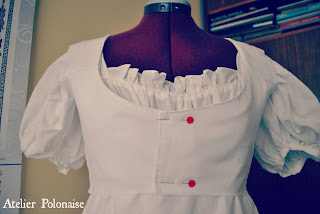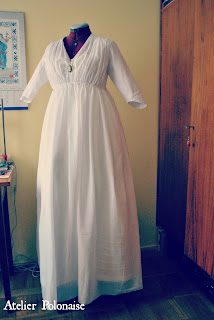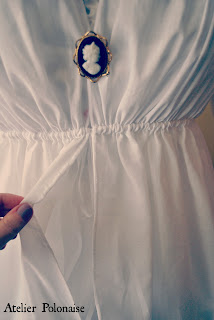Skończyłam szyć dwie koszule. Szczerze było to moje pierwsze podejście aby uszyć koszulę ponieważ dotąd używałam jednej kupionej w second handzie. Nowe koszule są uszyte w całości ręcznie i szyłam wg wskazówek Garsult'a zawartych w książce L'Art de la lingere (1771) skąd wzięłam wykrój oraz z książki Costume close up Lindy Baumgarten i Johna Watsona, gdzie przede wszystkim opisane zostały ściegi jakimi szyło się bieliznę w XVIII wieku. Pomocną okazała się ta strona opisująca jak krok po kroku powinno się łączyć poszczególne elementy wykroju.
I finished sewing two shirts. Honestly this was my first attempt to sew a shirt because the one I used previously purchased in the second hand shop. New shirts are sewn entirely by hand and sew according to the instructions contained in the book Garsult'a L'Art de la lingere (1771) where I took a pattern and another book Costume close up Linda Baumgarten and John Watson, where he primarily described the stitches for underwear in the eighteenth century. I find too a helpful page describing how to step by step should be to combine the elements of the pattern.
.jpg) |
| cotton shift, koszula batystowa |
Pierwsza z nich jest koszulą uszytą z bawełnianego batystu, wzór z Garsult'a określony jako litera C a druga koszula uszyta z lnu wg wzoru A. Obie określone przez autora jako l'anglaise. Podkrój szyi jest gładki bez tasiemki ściągającej.
The first of these is the shirt sewn with cotton batiste, Garsult pattern described as pattern C and the second made of linen shirt as pattern A. Both defined by the author as a l'anglaise. Neck cut is smooth without any ribbons
.jpg) |
| Linen shift, koszula lniana |
W lnianej koszuli dodatkowo wyhaftowałam inicjały oraz rok, w którym koszula została uszyta. Wzory haftu pochodzą także z książki Garsault'a
In addition,on a linen shirt I embroidered initials and the year in which the shirt was sewn. Embroidery designs also come from books of Garsault
.jpg) |
| embroidery initials, haftowane inicjały |

.jpg)
.jpg)
.jpg)
.jpg)

















+Sarah+Trumbull+with+a+Spaniel.jpg)






























